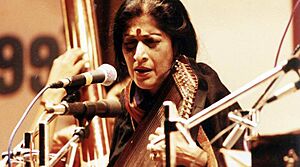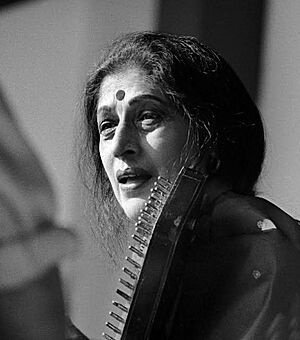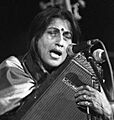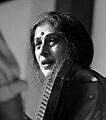Kishori Amonkar facts for kids
Quick facts for kids
Kishori Amonkar
|
|
|---|---|

Vidushi Kishori Amonkar
|
|
| Background information | |
| Born | 10 April 1932 Bombay, Bombay Presidency, British India |
| Died | 3 April 2017 (aged 84) Mumbai, Maharashtra, India |
| Genres | Hindustani classical music |
| Instruments | Vocals |
| Awards: Padma Vibhushan 2002 | |
Kishori Amonkar (born April 10, 1932 – died April 3, 2017) was a famous Indian classical singer. She was known for her amazing voice and unique style. Kishori belonged to a special group of musicians called the Jaipur gharana. A gharana is like a musical family or school. It means musicians share a special way of singing.
She was one of the best classical singers in India. Kishori Amonkar sang in the classical style called khyal. She also performed lighter classical songs. These included thumri and bhajan songs. Kishori learned music from her mother, Mogubai Kurdikar. Her mother was also a classical singer from the Jaipur gharana. Kishori Amonkar loved to try new vocal styles in her career.
Contents
Kishori Amonkar's Musical Journey
Early Training and Learning
Kishori Amonkar's first music lessons were from her mother. Her mother, Mogubai Kurdikar, was a very strict teacher. Kishori said her mother taught her by singing musical phrases. Then, Kishori had to repeat them exactly.
When she was young, Kishori traveled with her mother to concerts. She would play the tanpura while her mother sang. The tanpura is an instrument that provides a drone sound.
In the early 1940s, Kishori started taking vocal lessons. She learned Hindustani classical music from many teachers. One important teacher was Anjanibai Malpekar. Anjanibai taught her a special technique called meend. This means gliding smoothly between musical notes. Kishori also learned from teachers of other gharanas. These included the Agra and Gwalior gharanas.
Her Unique Singing Style
Kishori Amonkar believed that music should not be limited. She said there is "only music," not just gharanas. She thought that dividing music into gharanas was like dividing it into castes. She wanted students to learn the rules of music. But she also wanted them to explore beyond those rules.
Kishori Amonkar mixed different styles in her singing. She took ideas from other gharanas. People praised her for this, but some also criticized her. She was a romantic singer. This means she cared more about showing feelings than strictly following old rules. She often changed the traditional ways of the Jaipur gharana.
Kishori said that the Jaipur gharana was the base of her style. But she added her own changes. For example, she used alapchaari. This is when a singer relaxes the connection between rhythm and notes.
She believed that music education should help students be creative. She wanted them to improvise on their own. She said her mother taught her this way. "You have to walk and run on your own," she explained. Kishori also listened to her own recordings. She did this to find ways to improve her singing.
Kishori Amonkar felt that emotion and spirituality were key to her music. She called music "a dialogue with the divine." She saw music as a way to reach a higher goal. In 2010, she wrote a book in Marathi. It was called Swaraartha Ramani. In this book, she shared her ideas about music.
A Leading Classical Singer
Kishori Amonkar became a very popular classical singer in the 1960s and 70s. Before this, she had to stop singing for a short time. She was ill and it affected her voice. During this break, she thought about her own singing style. She wanted a style that went beyond the traditional gharanas.
Kishori also spoke about how women musicians were treated. She learned from her mother to be professional. She made sure musicians were paid fairly for their performances. Once, she refused to sing because the audience was not respectful. She believed performers deserved respect.
She created many new musical compositions for different ragas. A raga is a melodic framework for improvisation. Kishori was also a popular speaker. She gave talks across India. She was famous for her lectures on rasa in music. Rasa means the feelings or emotions in music.
Lighter Music and Films
Besides classical music, Kishori Amonkar also sang lighter songs. She performed many thumri and bhajan songs. She even sang for some film soundtracks. She sang for the 1990 Hindi film Drishti. She also sang playback for the 1964 movie Geet Gaya Patharon Ne.
However, she decided not to sing for films much after that. She felt that film music made her change the swaras (notes) too much. The swaras are the most important part of any music for her. Also, her mother did not approve of her working in films. Her mother reportedly told her she could not touch her tanpura if she continued.
Life and Passing
Kishori Amonkar was born in Bombay on April 10, 1932. Her father passed away when she was seven years old. Her mother, Mogubai Kurdikar, raised Kishori and her two younger siblings.
Kishori was married to Ravindra Amonkar, who was a school teacher. They had two sons, Bibhas and Nihar. People sometimes said Kishori was "temperamental." She explained that this was because she insisted on respect for performers. Also, she liked to be alone before concerts to prepare. She said, "The audience cannot disturb the loneliness of an artiste." Kishori did not enjoy giving interviews to the press.
Kishori Amonkar lived in Mumbai. She passed away peacefully in her sleep on April 3, 2017. She was 84 years old. The Prime Minister of India, Narendra Modi, shared his sadness on Twitter. He wrote that her death was a great loss to Indian classical music.
Awards and Lasting Impact
Kishori Amonkar received many important awards in India. These included the Padma Bhushan in 1987 and the Padma Vibhushan in 2002. These are high civilian honors. She also received the Sangeet Natak Akademi Award in 1985. In 2009, she got the Sangeet Natak Akademi Fellowship.
Many other musicians admired Kishori Amonkar's talent. The famous tabla player, Zakir Hussain, praised her performances. He said they were "landmark performances" that people would remember for centuries. The Carnatic singer T.M. Krishna also admired her. He said she gave classical music "everlasting newness and freshness."
A documentary film called Bhinna Shadja was made about Kishori Amonkar. It was directed by Amol Palekar and Sandhya Gokhale. Many of Kishori Amonkar's students became famous classical musicians themselves. Her granddaughter, Tejashree Bibhas Amonkar, is also a classical musician. Kishori Amonkar trained her granddaughter.
Images for kids






